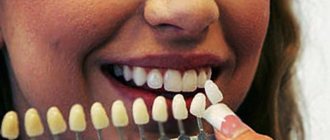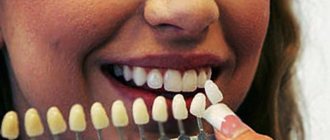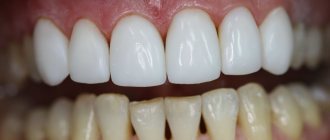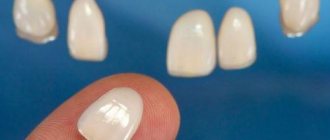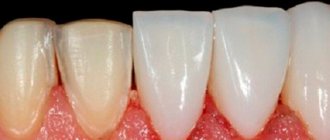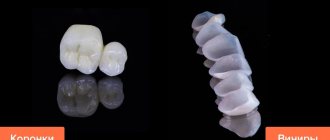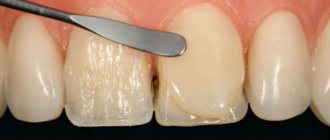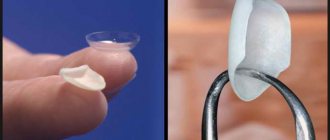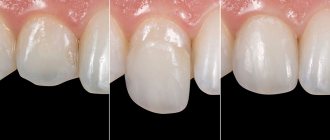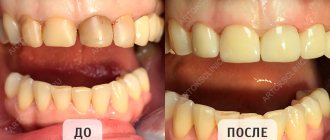Thin dental coverings used to correct enamel imperfections are called veneers. Used by dentists to restore and improve the aesthetics of the anterior group of teeth. Veneers made by layer-by-layer coating of enamel with composite materials are called “composite”.
A special feature of the plates is the ability to cover teeth directly in the patient’s oral cavity. Therefore, they are also called therapeutic or direct veneers. Moreover, the production of such structures in Leaderstom clinics takes place directly in the doctor’s office during one visit.
The dentist applies a reflective paste to the visible surface of the tooth in layers, which gives the tooth a natural appearance. In addition, in these areas, a composite veneer will last a long time, since the front teeth are not involved in chewing and therefore do not experience strong stress during eating.
When properly cared for, composite veneers are highly wear-resistant.
How is restoration done?
In Leaderstom clinics, plates of composite material are made directly in the patient’s mouth, i.e. direct method.
Enamel coating is carried out in one medical appointment and is carried out in the dental chair in several stages:
- the dentist examines and assesses the condition of the patient’s teeth that require restoration;
- in accordance with the tone of the remaining teeth, the doctor and patient select the shade of the future lining according to the Vita scale;
- a thin layer of enamel is removed from the front surface of the teeth that will be involved in the restoration in accordance with the thickness of the future plate (0.3-0.7 mm);
- the ground surface of the tooth is covered layer by layer with a composite material;
- After the applied mass has dried, the surface of the veneer is ground and sanded.
When are they recommended?
If it is necessary to restore the aesthetics of the entire smile area, then usually, the dentists of our clinic recommend their patients to install indirect veneers, while for the restoration of one or two teeth, composite onlays are the ideal solution.
Indications for direct restoration include the following defects:
- presence of uneven teeth;
- large gaps between them;
- presence of chips, microcracks of enamel;
- change in the shade of teeth (darkening, yellowness, spotting, etc.)
In what cases should you install
Attention! Typically, veneers are installed only at the request of the patient; there is no need to have indications for this. As a rule, these products are used to improve the shape and color of teeth, and also if the patient dreams of having a Hollywood smile. But still, there are some indications for which veneers are installed:
- ugly and uneven shape of teeth;
- the presence of a pronounced yellow tint of the front incisors;
- change in shade after depulpation;
- the presence of an enamel erosion process, for example, after a tooth has chipped due to any reason;
- wide spaces between teeth with an unsightly shape, as well as rotated, crowded incisors;
- can be used when other recovery methods have not provided the desired results.
Composite veneers are a method of aesthetic correction of a patient’s smile, which is used for cracks and chips in teeth, discoloration, curvature of teeth, and large interdental spaces.
Contraindications
Restorations with composite materials have the same limitations as indirect veneers.
Despite this, some of the contraindications are relative, after eliminating which it becomes possible to install composite veneers.
These include:
- inadequate hygienic oral care;
- malocclusion;
- diseases of the gums and teeth in the acute stage;
- night grinding of teeth (bruxism).
Absolute contraindications to restoration include:
- pathological abrasion of teeth;
- the presence of thinned enamel;
- serious enamel defects that cannot be hidden even after installing overlays;
- if the teeth to be veneered are pulpless;
- tooth mobility.
What to choose: veneer, crown or braces
If there are no contraindications to installing veneers, it is better to give them preference. The main difference between the devices is that the use of a crown requires grinding of the tooth, which after such processing becomes like a “stump”. Sometimes it is necessary to remove the nerve. Installing a veneer involves removing the top layer of enamel on the front wall near the cutting edge.
Patients often choose between veneers and braces, not knowing which to choose. In fact, it all depends on how crooked the teeth are. Veneers only mask the defect and do not correct it. This method justifies itself only when the result is needed urgently or it is simply necessary to hide a defect.
Veneers can correct the bite only in cases of minor pathology. Doctors usually advise correcting the bite without grinding the enamel using braces.
Life time
Unlike traditional dental panels, composite veneers require renewal every 5 years with proper care.
In addition to the usual daily hygiene procedures using a toothbrush, paste, and thread, composite veneers need polishing. This will require regular visits to the dentist.
To extend the service life of the linings, the plates should not be subjected to rough mechanical stress. To prevent damage to the restoration during sleep, our dentists will recommend protecting the plate at night with a mouthguard and help you choose a suitable design.
Colors of Emax ceramic veneers
Emax glass-ceramic microprostheses differ from conventional ceramic veneers in their manufacturing technology. Accordingly, for overlays of this type there is a separate color scale - Vita 3D-Master. Here, not two, but three color selection options are used.
- Brightness - from 1 to 5.
- The tonality is L (more yellow) and R (more red).
- Saturation - from M1 to M3.
To determine the shade of the future veneer, the doctor first determines its brightness, moving from the darkest to the lightest, then selects the intensity level M and, lastly, the tonality L or R. The color codes of the Vita 3D-Master palette consist of three symbols - for example, 3M2 .
Advantages and disadvantages
Reconstructions made from composite materials have a number of advantages over traditional veneers:
- they do not require the use of expensive materials and are easy to manufacture. Therefore, the cost of such structures is low and available to a wide range of patients;
- Since the installation of veneers does not require taking impressions and then sending them to the laboratory, the production of composite onlays is carried out without much time. This procedure is carried out directly in the doctor’s office within one day.
Like any medical procedure, any installation of any type of veneers, including composite ones, may have disadvantages.
The most significant negative points include:
- the lack of complete adherence to the tooth surface contributes to the accumulation of plaque in border areas and the proliferation of bacterial flora. The presence of bacterial deposits leads to the development of caries and inflammation of the gums. A loose fit of the composite to the dental crown is one of the main disadvantages of restoration with composite veneers;
- lack of aesthetics in comparison with ceramic overlays;
- high sensitivity of the material to increased mechanical loads when chewing or biting off hard objects, which can easily cause structural failure in the form of chips and cracks;
- over time, roughness and grinding of the linings may appear;
- change in the color of the dental plate as a result of consuming products that contain coloring pigments (red wine, blueberries, cherries, tea, coffee, etc.).
Indications
Composite overlays allow you to return a partially destroyed tooth (or several units at once) to their original appearance and functionality, correct or completely change the shape, cover up some minor visual defects, and adjust the shade.
Their installation is recommended when:
- shade anomalies when present: fluorosis, pigmented spots, enamel hypoplasia, tetracycline or demineralized units, post-traumatic or age-related discoloration, many “old” fillings;
- acquired or congenital structural changes in the hard tissues of the dental surface facing the cheeks and lips (vestibular), imperfections in shape, erosion, changes in proportion, wedge-shaped defect, necrosis;
- disposition (abnormal arrangement of teeth relative to each other): with trema, deviation forward or backward, reversal, diastema;
- developmental anomalies: hypoplasia (underdevelopment of dental tissues) or amelogenesis (improper development of enamel).
Many patients resort to composite veneers to change the group of teeth, for example, visually changing canines to lateral incisors.
What is the price
As follows from the above, the cost of direct restoration is lower than the manufacture and installation of veneers from composite materials. The price of the procedure differs in different clinics and depends not only on the region. The cost of restoration directly depends on the status of the medical institution and the professionalism of the dentists.
Installation of composite veneers will cost more in Moscow clinics than in other regions of Russia.
If we are talking about economy-class dentistry, then the price for restoration with composite veneers will be in the range of 3,000 – 4,000 rubles per tooth.
In premium clinics, the cost of such a procedure can reach 16,000 rubles.
The higher the cost of installing a composite onlay, the better the quality of the restoration result and the professionalism of the dentist.
Cost of dental restoration in Leaderstom clinics
| Service | Price in rubles |
| Consultation | for free |
| Restoration of one tooth | 3500 |
| Composite veneer for 1 tooth | 7000 |
| Veneer E.Max | from 19000 |
| Cerec veneer | from 15000 |
| Lumineer installation | from 50000 |
| Zirconium dioxide veneer | from 40000 |
| Ultraneers | 45000 |
Characteristic
Composite veneers are presented in the form of a thin overlay that is placed only on the front side of the incisor. With their help, they perform a kind of artistic restoration of the tooth, which is located in the smile zone.
Veneers are made using composite reflective materials, which are applied layer by layer to the incisor. The entire manufacturing process takes place immediately in the oral cavity, right there in the office of a specialist (dentist). To correct tooth errors with the help of composite veneers, one appointment will be enough, which is why this method of restoration has received a second name - therapeutic.
Since the front part of the tooth is subject to minimal pressure and abrasion during food intake, such plates can last quite a long time. Their service life can be increased through proper care and compliance with certain operating rules, which we will consider later.
Reviews
At the moment, dental restoration with veneers using composite materials is quite rare. And yet such cases do occur. Reviews about this method of restoring dental aesthetics are the most contradictory.
- I have suffered from caries since childhood. When the process moved to the front teeth and the fillings became noticeable to others, I consulted a doctor. The dentist suggested using veneers. But, since my salary is small, I had to make a choice in favor of therapeutic pads. The installation was completed in one visit. Together with the doctor, we selected the appropriate color so that the difference in the shade of the enamel would not be visible. The overlay has been in place for 3 years, although it has faded a little.
- There was a chip in the front incisor, and in order to hide the defect, the dentist suggested restoring the tooth with a composite material. The defect was removed quickly, but the appearance of the crown was different from other teeth. It looked a little unnatural. I had to install a ceramic plate.
- Several years ago I had two front teeth restored with composite veneers. The color and appearance of the onlays are no different from my natural teeth. If we're really being picky, the enamel looks less transparent. But this deficiency can also be corrected if you regularly visit the dentist to polish your teeth.
Bleach teeth color - Hollywood smile
No matter how much natural beauty is valued, many patients dream of a dazzling white smile, like that of movie stars. For such cases, the Vita palette includes four snow-white shades “Bleach”, which do not exist in nature.
Bleach 1 and Bleach 2 are bright white enamel with virtually no yellow pigment. Such shades are associated with shockingness and can only look good on stage, in the spotlight and against the backdrop of bright makeup. In shades Bleach 3 and Bleach 4 a small percentage of yellow pigment appears, but they still remain outside the natural palette.
The bleach color of ceramic veneers looks more appropriate on dark skin. Those with Northern European appearance are better off giving preference to natural shades a1 and b1 - they are just as light, but look more organic.
